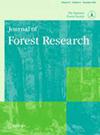Estimating the spatial distribution of soil organic carbon and soil total nitrogen concentrations by remote sensing methods: a case study in a forest-dominated Alpine Watershed, Western China
IF 1.1
4区 农林科学
Q3 FORESTRY
引用次数: 0
Abstract
ABSTRACT In ecologically fragile areas, accurate estimation of soil organic carbon (SOC) and soil nitrogen (STN) concentrations is a prerequisite for sustainable development. On the basis of field sampling data and remote sensing technology, this study divided the topsoil (0–30 cm) into three soil layers of 0–10 cm, 10–20 cm, and 20–30 cm to carry out SOC and STN concentrations estimation experiments in the Qilian Mountains in western China. To estimate SOC and STN concentrations, a stepwise multiple linear regression model was used. A total of 119 topsoil samples and nine remotely sensed environmental variables were collected and used for model development and validation. The results show that the stepwise multiple linear regression model has stable simulation performance. The modified soil-adjusted vegetation index (MSAVI), perpendicular vegetation index (PVI), aspect, elevation, and solar radiation were the key environmental variables affecting soil organic carbon and total nitrogen content. The ranking of SOC concentrations in the 0–30 cm soil layer was bush woods > spruce forests > sabina forests > alpine meadows > steppes, with mean concentrations of 117.98 g/kg, 101.35 g/kg, 83.09 g/kg, 78.76 g/kg, and 37.08 g/kg, respectively. The ranking of STN concentrations in the 0–30 cm soil layer was bush woods > alpine meadows >spruce forests > sabina forests > steppes, with mean concentrations of 4.77 g/kg, 3.71 g/kg, 3.19 g/kg, 3.27 g/kg, and 1.92 g/kg, respectively. Both SOC and STN concentrations decreased significantly with increasing soil depth.遥感方法估算土壤有机碳和土壤总氮浓度的空间分布——以中国西部以森林为主的高山流域为例
摘要在生态脆弱地区,准确估计土壤有机碳(SOC)和土壤氮(STN)浓度是可持续发展的前提。本研究在野外采样数据和遥感技术的基础上,对表层土(0~30 cm)分成0–10的三个土层 厘米,10-20 厘米和20-30 cm在中国西部祁连山进行SOC和STN浓度估算实验。为了估计SOC和STN浓度,使用了逐步多元线性回归模型。共收集了119个表层土样本和9个遥感环境变量,用于模型开发和验证。结果表明,逐步多元线性回归模型具有稳定的模拟性能。改良土壤调整植被指数(MSVI)、垂直植被指数(PVI)、坡向、海拔和太阳辐射是影响土壤有机碳和总氮含量的关键环境变量。0–30内SOC浓度的排名 cm土层为灌木林>云杉林>沙柏林>高山草甸>大草原,平均浓度为117.98 g/kg,101.35 g/kg,83.09 g/kg,78.76 g/kg和37.08 g/kg。STN浓度在0–30范围内的排名 cm土层为灌木林>高山草甸>云杉林>沙柏林>大草原,平均浓度为4.77 g/kg,3.71 g/kg,3.19 g/kg,3.27 g/kg和1.92 g/kg。SOC和STN浓度均随土壤深度的增加而显著降低。
本文章由计算机程序翻译,如有差异,请以英文原文为准。
求助全文
约1分钟内获得全文
求助全文
来源期刊

Journal of Forest Research
农林科学-林学
CiteScore
3.00
自引率
6.70%
发文量
62
审稿时长
3 months
期刊介绍:
Journal of Forest Research publishes original articles, reviews, and short communications. It covers all aspects of forest research, both basic and applied, with the aim of encouraging international communication between scientists in different fields who share a common interest in forest science.
 求助内容:
求助内容: 应助结果提醒方式:
应助结果提醒方式:


